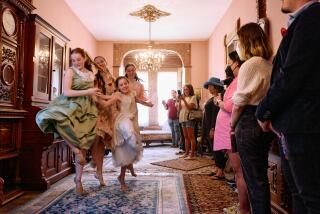BALLET REVIEW : Joffrey’s Star-Cross’d Lovers
- Share via
John Cranko’s “Romeo and Juliet” has always been a stretch for the Joffrey Ballet.
The ornate Shakespearean production, originally devised for the Stuttgart Ballet in 1962 and first ventured by this company in 1984, ideally demands a cast of thousands. Not counting extras and ringers, the Joffrey roster currently numbers 36.
The impact of the ballet relies as much on grandiose dramatic projection as it does on ensemble virtue. Essentially, the youthful, ultra-versatile, preposterously hard-working Joffrey dancers are movers, not actors.
The first of this season’s five performances of “Romeo,” Friday night at the Dorothy Chandler Pavilion, found the dauntless company performing as if lives were at stake. True, the crowd scenes looked a little underpopulated, and the protagonists projected only generalized emotions. But the group spirit was triumphantly willing.
One might not have left the performance shattered by the plight of the star-cross’d lovers. One did leave, however, feeling over-riding admiration for a company that ignores adversity with such verve and such obvious dedication.
The basic elements were in order. The broad contours of Cranko’s frequently clever, sometimes poignant, always picturesque choreography were appreciatively delineated. Jurgen Rose’s elaborately quirky decors framed the action flexibly and brightly. Allan Lewis and the locally recruited orchestra tended sensitively to Prokofiev’s wondrously heroic, unabashedly romantic score.
Tom Mossbrucker, one of only two Joffrey danseurs currently entrusted with Romeo, danced with honest clarity and modest virtuosity. He was strong, reliable, sympathetic and, alas, bland.
Jody Gates--his technically proficient, surprisingly robust Juliet--settled for similar platitudes much of the time. Occasionally, an accent got distorted. Her wide-eyed wonder in the introductory episodes inadvertently suggested soubrette calculation, and her backward swoons in the first duet with Romeo seemed unintentionally comical. She gained authority, however, as tragedy beckoned, and brought the poignance of simplicity to the death scene.
Carl Corry pranced and smirked with energetic charm as Mercutio. Tyler Walters, the alternate Romeo, exuded sinister bravado as Tybalt. Charlene Gehm’s aristocratic finesse almost mitigated the hysterical excesses Cranko imposed upon Lady Capulet at Tybalt’s demise. Daniel Baudendistel danced Paris with elegance and ardor worthy of a Romeo.
The sword and fruit fights proceeded with uncommon relish. The assorted clowns, nobles, servants and townsfolk did their double--nay, triple--duties with vigor, though the trio of Gypsies (a.k.a. prostitutes) seemed more prissy than the mores of 14th-Century Verona might dictate.
The big audience mustered big ovations.
More to Read
The biggest entertainment stories
Get our big stories about Hollywood, film, television, music, arts, culture and more right in your inbox as soon as they publish.
You may occasionally receive promotional content from the Los Angeles Times.










